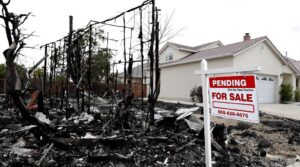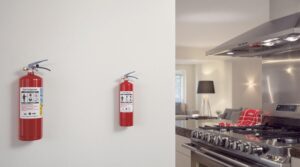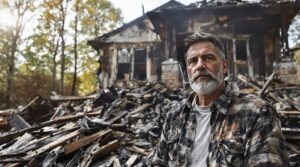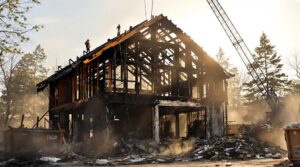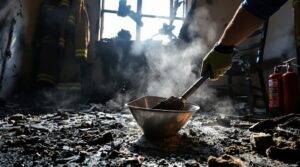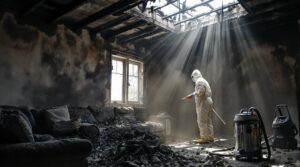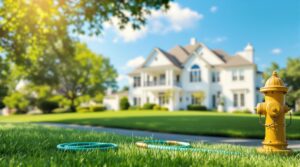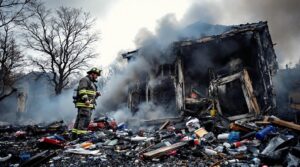Homeowners insurance typically covers fire damage, providing protection for the home's structure and personal belongings. Dwelling coverage allows for repair or rebuilding, while personal property coverage addresses damaged items. Additional support is available through loss of use coverage, which aids with temporary housing costs if the home is uninhabitable. Effective claims management, potentially with the help of public adjusters, optimizes settlement outcomes. Discover more about ensuring adequate coverage and successful claims processes.
Key Takeaways
- Homeowners insurance typically covers fire damage to the dwelling and personal property.
- Dwelling coverage assists in repairing or rebuilding fire-damaged home structures.
- Personal property coverage helps replace belongings damaged by fire, like furniture and electronics.
- Loss of use coverage compensates for temporary housing costs if the home is uninhabitable.
- Policyholders should understand coverage limits and exclusions for adequate compensation after a fire.
Understanding Fire Coverage in Homeowners Insurance
While many homeowners may assume their insurance provides extensive protection, understanding the specifics of fire coverage in homeowners insurance is essential. Typically, fire damage is considered a standard peril covered by homeowners insurance, including damage to both the dwelling and personal property. Dwelling coverage focuses on the repair or rebuilding of the home's structure post-fire, while personal property coverage replaces damaged belongings such as furniture and electronics. Additionally, loss of use coverage can offer financial relief for temporary housing and increased living expenses if the home becomes uninhabitable. Studies show that working with licensed public adjusters can increase settlement amounts by up to 500% for non-catastrophe claims. Policy limits dictate the extent of coverage, and homeowners are advised to regularly review these limits alongside any exclusions to guarantee adequate protection. Moreover, understanding the specific endorsements related to fire damage can prevent unforeseen gaps in coverage. This thorough understanding aids in serving others by guaranteeing preparedness and resilience in the face of potential fire-related disasters.
Dwelling and Other Structures Protection
The scope of dwelling and other structures coverage in homeowners insurance provides a framework for understanding the protection offered against fire damage, including the repair or rebuilding of both the main home and detached structures. Policy limits play a critical role in determining the extent of coverage, necessitating thorough examination by homeowners to guarantee adequacy relative to potential fire losses. Additionally, comprehension of the claim process, including documentation and timelines, is essential for homeowners seeking compensation for fire-related damages. Standard policies cover personal property and liability protection alongside structural damage coverage.
Coverage Scope Details
Homeowners insurance provides critical protection through dwelling and other structures coverage, guaranteeing that both the main home and any detached structures are safeguarded against fire damage. Dwelling coverage specifically addresses repairs or replacement of a home's structure, while other structures coverage extends to garages, sheds, and fences. Coverage limits are essential, as they dictate the extent to which homeowners insurance covers potential fire damage. The insured property must be assessed to prevent underinsurance, which could leave gaps in protection. Policies might include endorsements such as extended replacement cost or guaranteed replacement cost, which accommodate rising rebuilding expenses. Additionally, verifying coverage adequacy helps guarantee personal belongings are suitably protected, aligning with the value of the property and potential inflation impacts. Regular maintenance records can support the claims process and potentially result in lower insurance premiums over time.
Policy Limits Explained
Understanding the policy limits associated with dwelling and other structures protection is fundamental for homeowners seeking thorough fire damage coverage. Dwelling coverage within a homeowner's insurance policy is intended to address repair or rebuilding costs of the home's structure after a fire, up to the specified policy limits. Similarly, coverage for other structures includes detached properties like garages, provided they are covered. The extent of coverage is determined by the property's value, anticipated replacement costs, and policy terms. Homeowners must regularly evaluate and adjust their coverage, ensuring it aligns with current rebuilding costs. Without adequate coverage, if rebuilding expenses surpass policy limits, homeowners may face out-of-pocket costs. Some insurance policies offer extended or guaranteed replacement cost coverage, enhancing financial protection. Working with a public insurance adjuster can increase claim settlements by 30-50% through recoverable depreciation coverage.
Claim Process Essentials
Initiating a fire damage claim involves meticulous documentation and prompt communication with the insurance provider. Homeowners should immediately document damaged items by capturing photos and videos, guaranteeing all affected possessions are recorded. This thorough documentation, alongside receipts for valuable items, is vital for accurate reimbursement of personal property losses. Additionally, an updated inventory of personal property, coupled with retained copies of the insurance policy, aids in maneuvering the claims process efficiently. Contacting the insurance company promptly post-incident is imperative to clarify the claims process and understand coverage limits and exclusions. Policies generally cover the dwelling and other structures, but verifying these details confirms homeowners comprehend the protection scope, facilitating a fair and expedient resolution of their fire damage claims. Working with public adjusters can significantly enhance settlement outcomes and ensure all damages are properly valued during the claims process.
Personal Property Coverage Details
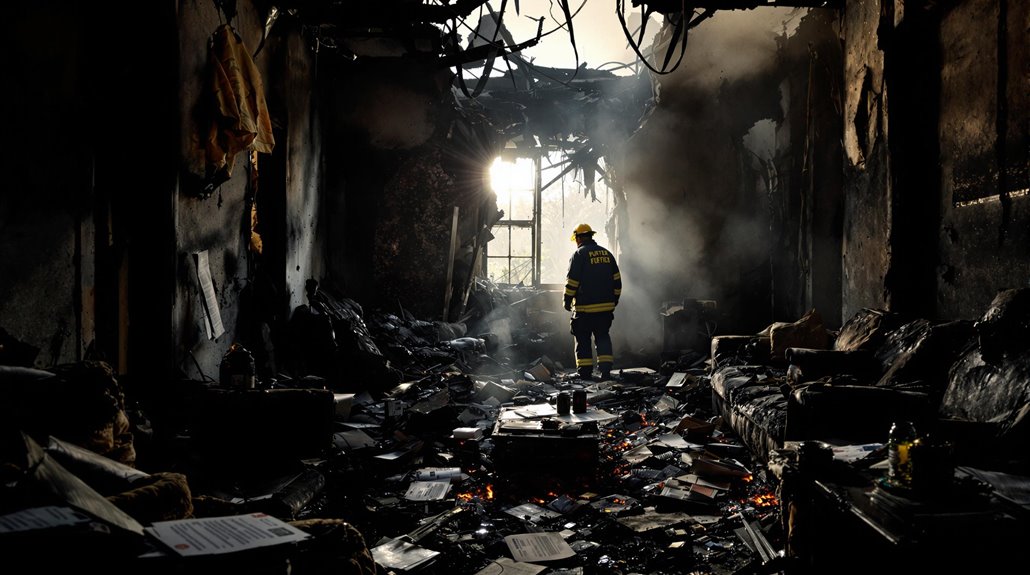
In examining personal property coverage within homeowners insurance, it is critical to understand both the coverage limits and the valuation methods employed. Coverage limits dictate the maximum reimbursement available for fire-damaged belongings, requiring homeowners to confirm these limits align with their property's value. Additionally, valuation methods, such as Actual Cash Value (ACV) and Replacement Cost Value (RCV), greatly influence the compensation amount, with each method offering distinct approaches to determining the worth of lost items. For maximum claim settlements, working with public adjusters can potentially increase compensation by 30-50% when filing for recoverable depreciation.
Coverage Limits Explained
When evaluating personal property coverage limits under homeowners insurance, it is essential to understand that these limits are determined by specific policy terms and conditions. Typically, personal property coverage for fire damage is a percentage of the dwelling coverage, ranging from 50% to 70%. Policyholders must be aware of deductibles, as these require out-of-pocket payments before insurance payouts occur. Replacement cost value coverage reimburses the full cost to replace items, while actual cash value accounts for depreciation. Accurate documentation of damaged items, including photographs and receipts, is vital for successful claims. Understanding the nuances of coverage limits allows individuals to better serve their communities by ensuring adequate protection and financial recovery in the aftermath of a fire. Effective communication between homeowners and insurance providers can significantly reduce claim processing delays and improve outcomes.
Valuation Methods Compared
Understanding the valuation methods for personal property coverage is vital for homeowners seeking to optimize their insurance claims after fire damage. Homeowners insurance typically offers two valuation approaches: Actual Cash Value (ACV) and Replacement Cost Value (RCV). ACV calculates the payout amount based on the depreciated value of items at the time of loss, whereas RCV covers the full replacement cost without considering depreciation. The choice between these methods affects the potential recovery, with an average fire damage claim payout being $83,519 from 2017 to 2021. Homeowners must understand policy specifics, including coverage limits, to guarantee adequate compensation. Proper documentation of belongings is essential for streamlining the claims process and maximizing the benefits under personal property coverage. Public insurance adjusters can help homeowners navigate complex claims and identify potential discrepancies in settlement offers.
Additional Living Expenses After a Fire
Facing the aftermath of a fire, homeowners often find their living arrangements disrupted, necessitating temporary relocation while their residence is repaired. Loss of use coverage within a homeowners insurance policy typically addresses these additional living expenses. This coverage may encompass costs for temporary housing, hotel stays, dining out, and extra grocery expenses incurred due to fire damage. However, reimbursements are subject to policy limits, which vary per insurance policy.
| Expense Type | Description | Documentation Required |
|---|---|---|
| Temporary Housing | Hotel stays or rental accommodations | Receipts, contracts |
| Dining Out | Meals purchased while displaced | Receipts |
| Grocery Expenses | Additional groceries due to lack of kitchen | Invoices |
Homeowners are advised to meticulously document expenses, ensuring receipts and invoices are preserved, facilitating effective claims. Understanding one's insurance policy is imperative, as exclusions or limitations could affect coverage. Proper documentation and comprehension of terms can greatly aid in managing this challenging period, reinforcing the support provided to those affected by fire damage. Local disaster relief services can provide additional assistance with temporary housing arrangements when insurance coverage falls short.
Navigating Claims and Potential Denials

How can homeowners effectively navigate the complex landscape of insurance claims following a fire? To maximize the chances of a successful claim, homeowners should meticulously document fire damage, including personal property loss, through photos and receipts. Thorough documentation supports the claim and minimizes potential denials. Understanding coverage limits is essential, as homeowners insurance generally includes dwelling, personal property, and loss of use coverage, though specific terms vary.
Awareness of policy exclusions, such as fire incidents caused by faulty wiring, is important, particularly for older homes. If the dwelling has been vacant over 60 days before the fire or if arson is involved, claims may be denied. Consulting with an insurance agent about potential endorsements can help homeowners align their coverage with needs, avoiding unexpected gaps. Working with public adjusters can significantly increase settlement amounts compared to self-managing claims. By taking these steps, homeowners can effectively manage claims and mitigate the risk of denials in the aftermath of fire damage.
Fire Prevention and Safety Measures
Although fire hazards pose substantial risks to homes, implementing strategic fire prevention and safety measures can greatly mitigate these dangers. Installing smoke alarms on every level and conducting monthly tests are essential steps in enhancing early fire detection. This proactive approach guarantees timely alerts, reducing potential damage and risk to occupants. Developing and practicing a thorough fire escape plan further reinforces preparedness, guaranteeing all household members know how to react swiftly during emergencies.
Moreover, addressing common fire causes, like faulty wiring and unattended cooking, through diligent preventive measures can greatly lower fire risks. Regular maintenance, such as clearing yard debris and maintaining gutters, helps reduce fire hazards and impedes fire spread. Incorporating nonflammable construction materials and fire-resistant landscaping creates a defensible space around the property, minimizing the chances of fire reaching the home.
Collectively, these strategies not only protect property but also enhance safety and peace of mind for occupants.
Frequently Asked Questions
What Kind of Fire Is Covered by Insurance?
Insurance policies typically cover fire types such as accidental fires, with coverage limits varying. Personal property, liability coverage, and restoration services are often included. Fire investigations and deductible amounts influence the claims process, while fire prevention remains essential.
Does Fire Count as Accidental Damage?
In the kingdom of insurance domains, accidental fires are often considered benign dragons. Homeowners insurance policies typically offer protection through liability coverage and dwelling repair, though exclusions and coverage limits guard the gates, emphasizing fire safety and prevention.
How Does Insurance Pay Out After a Fire?
Insurance pays out after a fire through a detailed fire damage assessment, considering the insurance claim process, payout limitations, policy exclusions, and coverage types. Documentation requirements, deductible impact, rebuilding costs, personal property, and loss of use are essential factors.
What Is Covered With Fire Damage?
Fire damage assessment evaluates dwelling coverage and personal property losses within policy limits, considering smoke damage and fire restoration costs. Additional living expenses are addressed, but exclusions list and claims process details should be reviewed alongside fire prevention tips.

